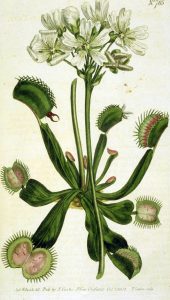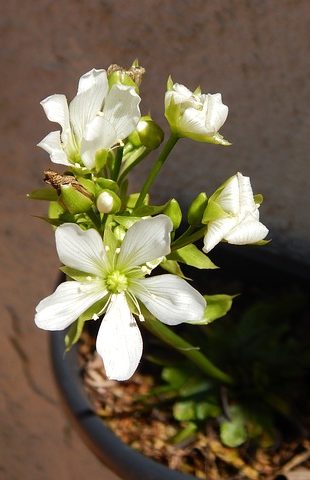As a novice grower, I got extremely excited when I saw a thick tubular flower stalk growing out of my Venus Fly Trap for the first time. I was so fascinated by their jaw-looking traps that I never realized Venus flytraps had flowers. Once I did some research, I decided to cut off the Venus flytrap flower stalks to avoid killing my plant.
““Venus flytraps are perennial plants, which means they bloom year after year. The flowers are white with green veins running from the base of the petal toward the edges.” National Wildlife Federation
Will my Venus flytrap die after flowering?
Short answer: It depends on your experience.

In spring, Venus flytraps flower. The process of producing those flowers takes a lot of energy from the plant. The flowers won’t kill the plant, but poor growing conditions can easily kill it. If you let the Venus flytrap flower, it will be and appear weak for several months. During those months, your plant is at risk of dying if the conditions are not optimal (light, moisture, soil, etc.). If you are a first-time or beginner grower, I would recommend to cut the stalks off before they flower. Then, during the summer months, your plant will continue growing and developing rapidly.
Experienced growers let their Venus flytraps flower, and they even harvest the seeds. However, experienced growers have experience and a standard setup featuring optimal growing conditions.
If you want to learn exactly what it means when your Venus flytrap flowers, you can read this article.
means when your Venus flytrap flowers, you can read this article.
How and when to cut the flowers off
The most important rule about cutting the flowers out is to do it as soon as possible. The longer you wait, the longer your plant will waste resources in producing those flowers. Once you have spotted the flower stalks, remove them immediately. Keep in mind that a single plant might attempt to grow several flowers during a season. Try your best not to miss any.
Use small gardening scissors to cut the flowers off. The process is standard, the same as cutting dead leaves or unwanted spurs. However, you must be especially careful with the rest of the plant. Try not to set any traps when you move or handle your Venus flytrap. The plant uses significant amounts of energy activating those traps, and your main goal in cutting off those flowers is to prevent unnecessary energy drainage.
Also, this article has a video and steps on how to remove the flower without harming the plant: Easy Steps to Remove Venus Fly Trap flowers.
What to do if my Venus flytrap already flowered?
 Once your Venus flytrap has flowered (or close to flowered), then the damage is already done. At this point, you should consider these two action items:
Once your Venus flytrap has flowered (or close to flowered), then the damage is already done. At this point, you should consider these two action items:
- Learn more about proper care for Venus flytraps and adapt your current set up.
- Learn about pollination and consider taking on a project to harvest Venus flytrap seeds. Here is a short rundown on the process of collecting seeds:
Collect Venus flytrap seeds
The first step to collect seeds is to let your Venus flytrap flower. Since you already have that, we can move on to the second phase: pollination. If you place your plants outside, natural pollinators will likely visit your plant and help you with the process. However, if your plants are indoors, you will have to assist them with the process. Venus flytraps are self pollinators. You only need one plant, which can pollinate itself and produce seeds.
Manual pollination is not a complicated process but might take some trial and error. With a brush or a small tool, you must transfer the flower’s pollen from the anther to the stigma. Attempt to pollinate every flower in your plant to increase your chances.
Once fertilized, your flowers will change dramatically in a couple of days. Their color will change; they will dry up and die. If you successfully pollinated the flower, it will leave Venus flytrap seeds behind. The seeds will be encapsulated in the remains of your dead flower. You can collect a few dozen seeds from each fertilized flower, and…that is how you collect seeds!
Why do Venus flytraps flower?
Like any other plant, flowers in Venus flytraps are meant for reproduction. Once a pollinator has transferred pollen from the anther to the stigma, the fertilized flowers produce seeds to reproduce. The exciting part about the pollination process in Venus flytraps is that the majority of animal pollinators are insects, and Venus flytraps eat insects. So, how do they reproduce? Well, here is an interesting explanation.
Venus flytrap flowers grow taller than their traps. When you observe a plant that has flowered, you will notice the flowers up high and the traps in the bottom. Venus flytraps developed this mechanism to separate pollinators from food.
“The predatory leaves of Venus flytraps are separate from their flowers. The flowers have bright green centers and white petals with green lines. They adorn the tops of tall stalks that extend beyond the leaves, which prevents pollinators from being trapped and eaten by the plant. (Venus flytraps also have fruit, which comes in the form of round, green pods containing shiny black seeds.)” – Venus Flytraps Have Surprising Pollinators … and They Don’t Eat Them, Elaina Zachos, National Geographic
Summary: Venus flytrap flower facts
- The process of flowering drains energy in Venus flytraps and stagnant their growth
- Your plant might take 2-4 years to reach maturity. Only then, it will start producing flowers
- Flower stalks have a thick cylindrical shape
- Each flower stalk will grow to develop a flower cluster
- Venus flytraps only flower during the spring, however, they might create multiple flower clusters
- After pollination, each flower can produce dozens of seeds

